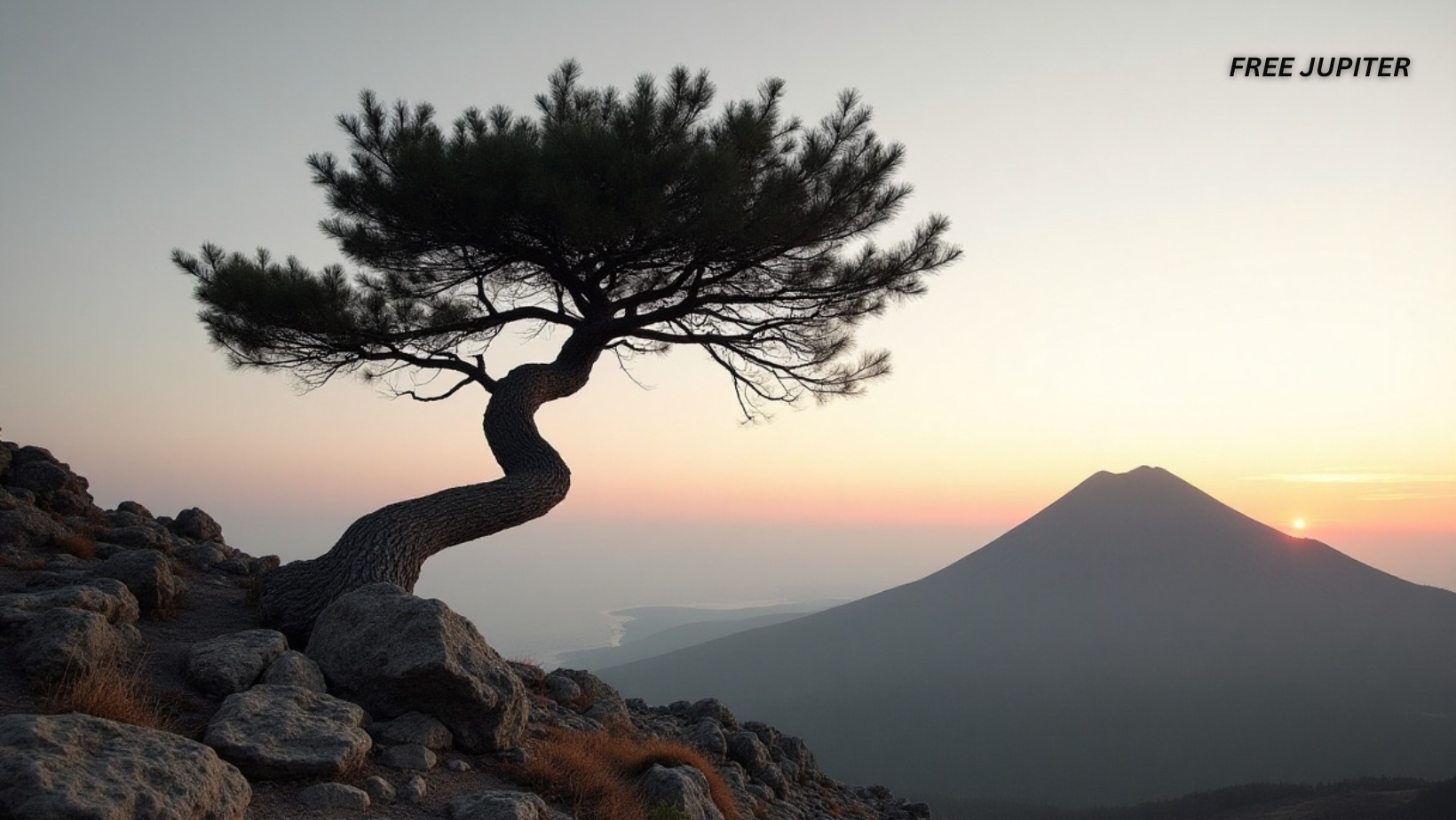Friendly Note: FreeJupiter.com shares general info for curious minds 🌟 Please fact-check all claims—and always check health matters with a professional 💙
For the millions of people living within reach of Earth’s restless volcanoes, the natural world might just offer a new kind of early warning system—one that is both subtle and surprisingly effective. Recent research reveals that trees, those quiet giants of the forest, can provide advance notice of volcanic unrest, and satellites circling above are learning to read their silent signals.
The Unseen Conversation Between Trees and Volcanoes
Deep beneath the surface, where magma stirs and pressure builds, volcanoes release a suite of gases long before lava ever breaks through. Among these, carbon dioxide emerges early, seeping upward through cracks and vents. For decades, scientists have recognized that this gas can serve as a harbinger of eruption, but detecting it directly from space has proven a formidable challenge due to the background noise of atmospheric CO₂.
Trees, however, are sensitive listeners in this subterranean conversation. As carbon dioxide rises from the depths, it is absorbed by nearby vegetation. The extra CO₂ acts like a potent fertilizer, stimulating plant growth and causing leaves to take on a noticeably richer, greener hue. This change, while subtle to the human eye, stands out clearly in satellite images.
Satellites as Nature’s Translators
The marriage of satellite technology and botanical insight is transforming volcano monitoring. NASA’s Landsat 8 and the European Space Agency’s Sentinel-2 are now trained not just on the volcanoes themselves, but also on the forests that cloak their slopes. These orbiting eyes can detect the faintest shifts in leaf color, offering a new way to gauge volcanic activity before traditional warning systems—such as seismic tremors or ground deformation—kick in.
Researchers from the Smithsonian Institution and NASA have spearheaded this approach, combining ground-based measurements with satellite observations. At sites like Costa Rica’s Rincón de la Vieja and Italy’s Mount Etna, teams have found a strong correlation between tree greening and the onset of volcanic unrest. The AVUELO project, which uses airborne instruments and even slingshot-launched sensors to sample forest canopies, bridges the gap between satellite data and on-the-ground reality.
Read more: Jupiter Used To Be Twice As Big — It Could Have Held 2,000 Earths Inside
Why Trees Make Better Sentinels Than Gas Sensors
Directly measuring volcanic carbon dioxide from space is notoriously difficult. The atmosphere is already saturated with CO₂ from natural and human sources, making it hard to distinguish the additional emissions from a restless volcano. Trees, by contrast, act as living sensors. Their response to increased CO₂—lush, vigorous growth—creates a visible signal that satellites can readily detect.
This method is especially valuable in remote or inaccessible regions, where installing gas sensors is impractical or dangerous. By watching the trees, scientists can monitor volcanoes from a safe distance, gathering data that would otherwise be out of reach.
The Science Behind the Greening
The process begins when magma beneath a volcano starts its slow ascent. As it rises, it releases gases, including carbon dioxide, which diffuse through the soil and into the roots of nearby trees. The extra CO₂ supercharges photosynthesis, leading to a burst of growth and a deepening of green in the canopy. This phenomenon is not just academic; it has been observed in real time at multiple volcanic sites around the world.
However, the story does not end with greening. As volcanic activity intensifies, the mix of gases can shift. Sulfur dioxide, which is toxic to plants, may begin to dominate, causing leaves to wither and turn brown. This dual response—greening before an eruption, browning during or after—provides a dynamic indicator of volcanic behavior.
The Limits and Promise of Tree-Based Monitoring
While the idea of trees as volcanic sentinels is compelling, it is not without its challenges. Not all volcanoes are surrounded by dense forests, and in arid or urban environments, the signal may be weak or absent. Other factors, such as drought, disease, or wildfire, can also affect tree health, complicating the interpretation of satellite data.
Still, for the many volcanoes nestled within lush, forested landscapes, this method offers a powerful new tool. It complements existing monitoring techniques, providing an additional layer of early warning that could save lives and reduce economic losses.
Beyond Volcanoes: Trees and the Climate Crisis
The implications of this research extend beyond volcano monitoring. Scientists are also interested in how trees respond to elevated carbon dioxide levels as a window into the future of Earth’s climate. As atmospheric CO₂ concentrations rise, understanding how forests will adapt—or struggle—is critical for predicting ecosystem health and resilience.
Researchers like Josh Fisher of Chapman University see tree responses to volcanic CO₂ as a natural experiment, offering insights into how forests might fare in a world with higher greenhouse gas levels. This dual focus—on both volcanic hazards and climate change—highlights the interconnectedness of Earth’s systems and the value of innovative monitoring approaches.
Read more:A Mysteriously Perfect Sphere Was Spotted in Space by Astronomers
The Human Element: Living with Volcanoes
For communities living in the shadow of active volcanoes, early warning is a matter of life and death. Traditional methods, such as seismic monitoring and gas sampling, have saved countless lives, but they are not infallible. Adding tree-based monitoring to the toolkit could provide crucial extra time for evacuation and preparation.
Consider the case of Redoubt Volcano in Alaska, where eruptions have disrupted air travel and threatened local communities. In 2009, the eruption of Redoubt led to the closure of Anchorage International Airport and the cancellation of hundreds of flights. Had there been a clearer early warning signal—such as a sudden greening of surrounding forests—authorities might have had more time to prepare and mitigate the impact.
The Future of Volcano Monitoring
The integration of satellite-based vegetation monitoring with traditional volcano surveillance represents a significant leap forward. As technology improves and datasets grow, scientists hope to refine their ability to predict eruptions with greater accuracy and lead time.
Projects like AVUELO, which combine airborne sensors with satellite imagery, are paving the way for more sophisticated monitoring networks. These efforts are not just about watching trees; they are about understanding the subtle ways in which nature communicates danger, and using that knowledge to protect vulnerable populations.
A Quirky Twist: Slingshots and Science
In a delightful blend of high-tech and low-tech, some researchers have turned to slingshots to deploy gas sensors into the forest canopy. These devices, more advanced than the toys of childhood, allow scientists to sample air at different heights, providing a detailed picture of how volcanic gases interact with trees.
This whimsical approach underscores the creativity and resourcefulness of the scientific community. It also highlights the importance of ground truth—verifying satellite observations with real-world measurements to ensure accuracy and reliability.
The Big Picture: Nature’s Early Warning System
The idea that trees can serve as natural sentinels for volcanic activity is both elegant and practical. By harnessing the power of satellite technology and the subtle responses of vegetation, scientists are unlocking a new dimension of volcano monitoring.
This approach does not replace traditional methods, but rather enhances them, offering a more complete picture of volcanic unrest. For the millions of people living near active volcanoes, it could mean the difference between disaster and safety.
Read more: New Research Traces Human Teeth Back to Fish Dermal Armor from 460 Million Years Ago
Conclusion: Listening to the Trees
As we look to the future, the collaboration between botanists, volcanologists, and satellite engineers promises to revolutionize our understanding of volcanic hazards. Trees, with their silent vigilance and subtle signals, are emerging as key players in the quest to predict and mitigate volcanic eruptions.
By listening to the whispers of the forest, we may gain the advance warning we need to protect lives, safeguard communities, and coexist more harmoniously with the powerful forces that shape our planet
Final Thoughts
The story of trees as volcanic sentinels is a testament to the power of interdisciplinary science. By combining the latest in satellite technology with a deep understanding of plant biology, researchers are opening new frontiers in disaster preparedness. For those who live in the shadow of volcanoes, these silent guardians of the forest may soon become their most reliable allies.










